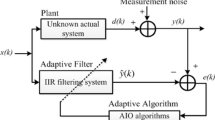Abstract
In this paper the digital infinite impulse response (IIR) filter design is modeled as an optimization problem. A new design method based on inclined planes system optimization (IPO) is introduced for the IIR system identification. IPO is a heuristic technique based on the dynamics of sliding motion along a frictionless inclined surface that has been demonstrated the reliable performance in solving of engineering complex problems. The effectiveness of the proposed method is verified in presence of the additive noise. In this work, both actual and reduced order identification of few benchmarked IIR plants is carried out in the simulations. Newton’s Mechanics-based, swarm intelligence based and conventional evolutionary algorithms are used to model the same examples and simulation results are evaluated. The final results clearly demonstrate the good performance and premier identification of the proposed method along with well-tuned other algorithms.

















Similar content being viewed by others
References
B. Widrow and S. D. Stearns, Adaptive Signal Processing, vol. 78, no. 7. 1985
Shynk JJ (1989) Adaptive IIR filtering. ASSP Mag IEEE 6(2):4–21
Goldberg DE (1989) Genetic algorithms in search, optimization, and machine learning, vol 412. Addison-wesley Reading Menlo Park, Boston
Kirkpatrick S, Gelatt CD, Vecchi MP (1983) Optimization by simulated annealing. Science 220(4598):671–680
Dorigo M, Maniezzo V, Colorni A (1996) Ant system: optimization by a colony of cooperating agents. Syst Man Cybern Part B 26(1):29–41
Kennedy J, Eberhart R (1995) “Particle swarm optimization,” Neural Networks. In: Proceedings., IEEE International Conference on, vol 4, pp 1942–1948
Valarmathi K, Devaraj D, Radhakrishnan TK (2009) Real-coded genetic algorithm for system identification and controller tuning. Appl Math Model 33(8):3392–3401
Chang W-D (2007) Nonlinear system identification and control using a real-coded genetic algorithm. Appl Math Model 31(3):541–550
Eftekhari M, Katebi SD (2008) Extracting compact fuzzy rules for nonlinear system modeling using subtractive clustering, GA and unscented filter. Appl Math Model 32(12):2634–2651
Zhu Z, Zhou J, Ji Z, Shi Y-H (2011) DNA sequence compression using adaptive particle swarm optimization-based memetic algorithm. IEEE Trans Evol Comput 15(5):643–658
Chen S, Luk BL (1999) Adaptive simulated annealing for optimization in signal processing applications. Sig Process 79(1):117–128
Howell MN, Gordon TJ (2001) Continuous action reinforcement learning automata and their application to adaptive digital filter design. Eng Appl Artif Intell 14(5):549–561
Karaboga N, Kalinli A, Karaboga D (2004) Designing digital IIR filters using ant colony optimisation algorithm. Eng Appl Artif Intell 17(3):301–309
He Y-L, Wang X-Z, Huang JZ (2016) Fuzzy nonlinear regression analysis using a random weight network. Inf Sci 364:222–240
Kalinli A, Karaboga N (2005) Artificial immune algorithm for IIR filter design. Eng Appl Artif Intell 18(8):919–929
Das S, Konar A (2007) A swarm intelligence approach to the synthesis of two-dimensional IIR filters. Eng Appl Artif Intell 20(8):1086–1096
Wang X-Z, Ashfaq RAR, Fu A-M (2015) Fuzziness based sample categorization for classifier performance improvement. J Intell Fuzzy Syst 29(3):1185–1196
Lin Y-L, Chang W-D, Hsieh J-G (2008) A particle swarm optimization approach to nonlinear rational filter modeling. Expert Syst Appl 34(2):1194–1199
Dai C, Chen W, Zhu Y (2010) Seeker optimization algorithm for digital IIR filter design. IEEE Trans Ind Electron 57(5):1710–1718
Rashedi E, Nezamabadi-pour H, Saryazdi S (2011) Filter modeling using gravitational search algorithm. Eng Appl Artif Intell 24(1):117–122
Sharifi M, Mojallali H (2013) Design of iir digital filter using modified chaotic orthogonal imperialist competitive algorithm (research note). Int J Eng Trans A 27(7):1033
Wang X, Huang JZ (2015) Editorial: uncertainty in learning from big data. Fuzzy Sets Syst 28(5):2329–2330
Chen S, Luk BL (2010) Digital IIR filter design using particle swarm optimisation. Int J Model Ident Control 9(4):327–335
Saha SK, Kar R, Mandal D, Ghoshal SP (2014) Harmony search algorithm for infinite impulse response system identification. Comput Electr Eng 40(4):1265–1285
Panda G, Pradhan PM, Majhi B (2011) IIR system identification using cat swarm optimization. Expert Syst Appl 38(10):12671–12683
Ashfaq RAR, Wang XZ, Huang JZ, Abbas H, He YL (2016) Fuzziness based semi-supervised learning approach for intrusion detection system. Inf Sci (in press)
Singh R, Verma HK (2014) Teaching–learning-based Optimization Algorithm for Parameter Identification in the Design of IIR Filters. J Inst Eng 94(4):285–294
Rashedi E, Nezamabadi-Pour H, Saryazdi S (2009) GSA: a gravitational search algorithm. Inf Sci 179(13):2232–2248
Mozaffari MH, Abdy H, Zahiri SH (2016) IPO: an inclined planes system optimization algorithm. Comput Inf 35(1):222–240
Chu S-C, Tsai P-W (2007) Computational intelligence based on the behavior of cats. Int J Innov Comput Inf Control 3(1):163–173
Krusienski DJ, Jenkins WK (2004) Particle swarm optimization for adaptive IIR filter structures. In: Evolutionary Computation, 2004. CEC2004. Congress on, vol 1, pp 965–970
Author information
Authors and Affiliations
Corresponding author
Rights and permissions
About this article
Cite this article
Mohammadi, A., Zahiri, S.H. Inclined planes system optimization algorithm for IIR system identification. Int. J. Mach. Learn. & Cyber. 9, 541–558 (2018). https://doi.org/10.1007/s13042-016-0588-x
Received:
Accepted:
Published:
Issue Date:
DOI: https://doi.org/10.1007/s13042-016-0588-x




